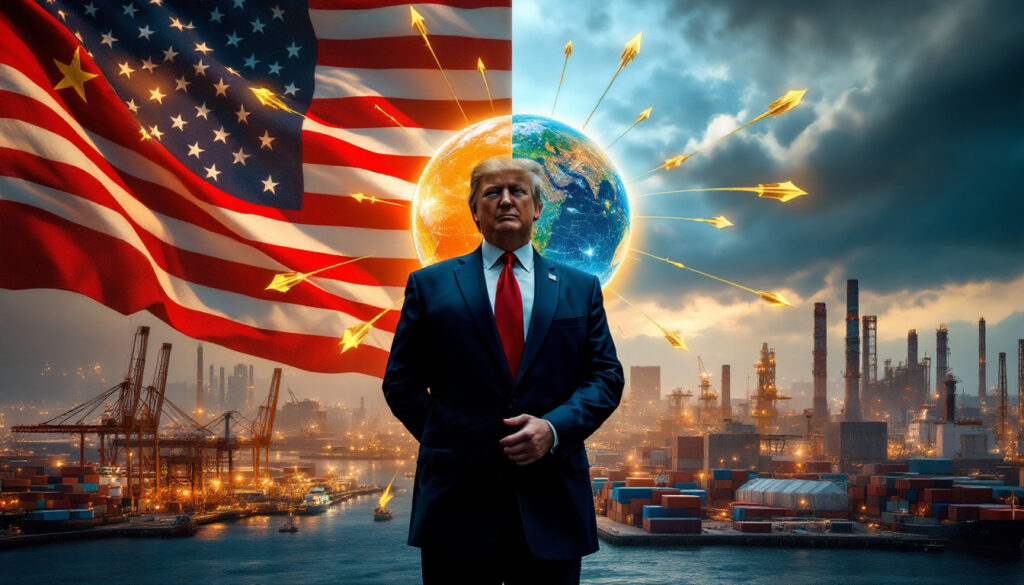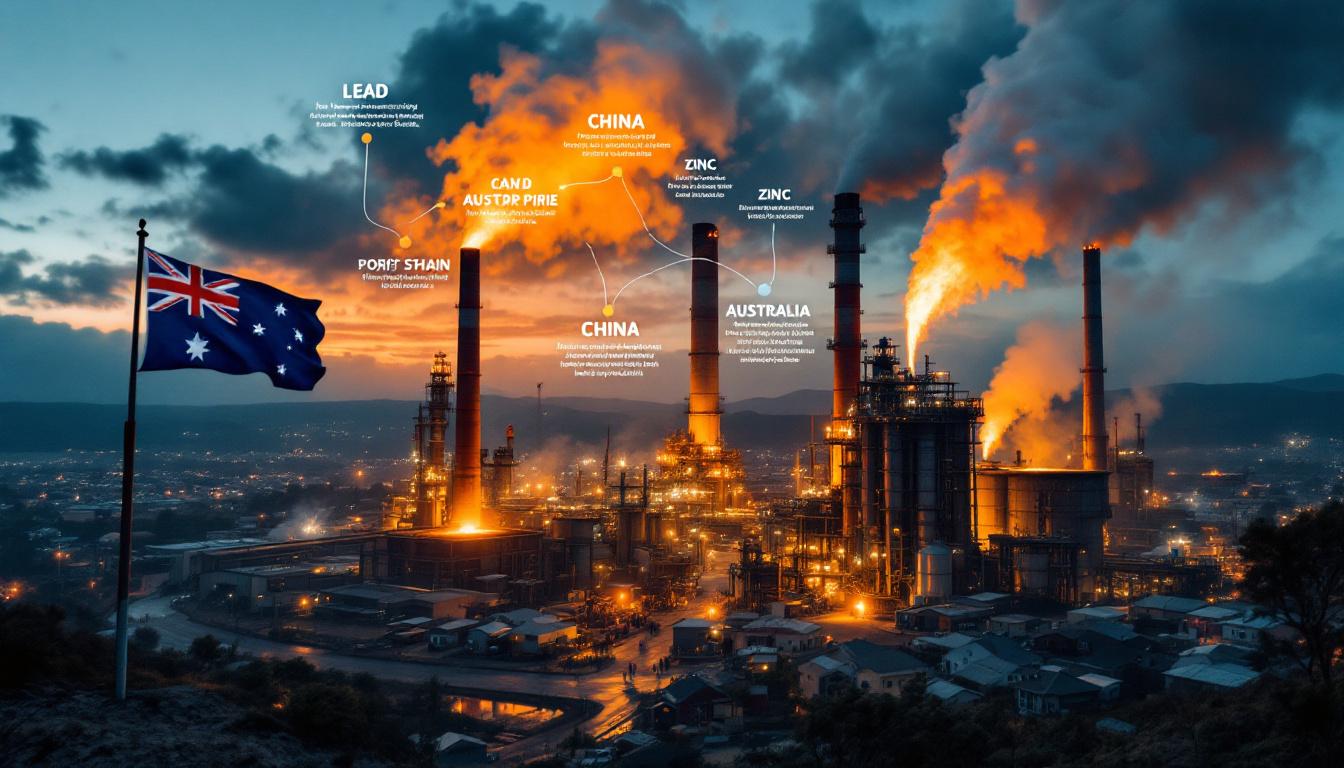Trump's Tariffs and China Trade War: Economic Impact and Global Consequences
The recent imposition of 104% tariffs on Chinese goods by the Trump administration, announced in April 2025, has intensified the ongoing US-China trade conflict, triggering significant disruptions across global markets and supply chains. This escalation follows a pattern of reciprocal trade measures, with China vowing to retaliate using "ample policy tools," including counter-tariffs and currency adjustments. Oil prices have plummeted below $60 per barrel amid fears of reduced demand from China, the world's largest crude importer, while analysts warn of a potential global recession. Understanding market dynamics insights is crucial as the tariffs, set to take effect immediately after midnight New York time, reflect the influence of China hawk Peter Navarro and underscore the administration's broader "reciprocal" tariff strategy targeting multiple trading partners.
What Are Trump's Tariffs on China?
Key Tariff Measures and Rates
The 104% tariff rate represents a dramatic escalation in trade policy, targeting a wide range of Chinese exports to the United States. These tariffs are scheduled for immediate implementation after midnight New York time, leaving businesses little time to adjust supply chains or inventory strategies. The measures are part of Trump's broader "reciprocal" tariff approach, which aims to match or exceed trade barriers imposed by other countries on American goods.
The current tariff structure specifically targets high-technology products, consumer electronics, and industrial components—sectors where China has developed significant competitive advantages. Economic analysts estimate these measures will affect approximately $300 billion worth of Chinese imports annually, potentially increasing consumer prices by 8-15% across affected categories.
Historical Context of US-China Trade Relations
The current tariff regime represents a significant intensification of the trade tensions that characterized Trump's first administration. Between 2018 and 2020, the U.S. imposed tariffs ranging from 10-25% on approximately $370 billion of Chinese goods, while China responded with tariffs on $110 billion of U.S. exports.
The 2020 "Phase One" trade deal temporarily eased tensions, with China committing to purchase an additional $200 billion in American goods. However, implementation fell short, with China achieving only 57% of the targeted purchase amounts by the end of 2021. This perceived failure has been cited by administration officials as justification for the current, more aggressive approach. The China–United States trade war has historically shown patterns of escalation followed by temporary agreements.
How Is China Responding to Trump's Tariffs?
Official Chinese Response
Beijing has taken a defiant stance, with the Commerce Ministry issuing a formal statement vowing to "fight to the end" against what it terms "American economic aggression." Chinese officials have announced retaliatory tariffs targeting U.S. agricultural exports, aircraft, and semiconductor equipment—industries concentrated in politically sensitive states.
The Chinese government has also mobilized state media to frame the conflict as a matter of national dignity, with People's Daily editorials emphasizing China's "long-term strategic patience" and capacity to withstand external pressure. This messaging suggests Chinese leadership is preparing its population for a prolonged economic struggle.
Economic Defense Mechanisms
China has emphasized that it possesses "ample policy tools" to counteract the tariffs' impact. These include:
Currency management strategies allowing controlled depreciation of the yuan, which has already fallen 6.4% against the dollar since the tariff announcement
Targeted tax relief for export-oriented manufacturers, including VAT rebates and accelerated depreciation allowances
Expanded domestic subsidies for affected industries, particularly in technology sectors
Increased government procurement quotas for products facing export challenges
These defensive measures draw on China's substantial foreign exchange reserves ($3.2 trillion) and its ability to direct state-owned banks toward priority lending areas.
What Impact Are the Tariffs Having on Global Markets?
Oil Market Disruption
Global oil markets have experienced severe turbulence, with prices sliding below $60 per barrel—representing a 22% decline in the month following the tariff announcement. This decline reflects widespread concern about reduced energy demand from China, which accounts for approximately 15% of global crude imports.
OPEC+ producers have called an emergency meeting to discuss potential production cuts, while U.S. shale producers have begun canceling planned expansion projects. Trump's energy policies are further complicating market dynamics, with Energy investment firms reporting that approximately 35% of planned drilling in the Permian Basin has been postponed indefinitely, with companies citing uncertainty about future Chinese demand.
Broader Financial Market Reactions
Financial analysts have characterized the market response as a global "shock," with widespread portfolio rebalancing toward defensive positions. Key developments include:
Equity market volatility indexes reaching levels not seen since the 2020 pandemic crisis
Corporate bond spreads widening by 120-180 basis points, particularly for companies with significant exposure to Chinese markets
Safe-haven currencies like the Swiss franc and Japanese yen appreciating 7-9% against major trading partners
Emerging market currencies experiencing capital outflows averaging $3.8 billion weekly since the announcement
How Are Global Supply Chains Being Affected?
Manufacturing and Production Disruptions
Multinational corporations are rapidly reconfiguring production networks to minimize tariff exposure. Major electronics manufacturers have already redirected 28% of their Chinese production capacity to Vietnam, Malaysia, and Mexico. Automotive suppliers report plans to relocate approximately 40% of their Chinese operations within the next 18 months.
Inventory management has become particularly challenging, with retailers increasing stock levels by an average of 42% to hedge against supply disruptions. This buildup has strained warehouse capacity in major logistics hubs, with vacancy rates falling below 3% in Southern California and northern New Jersey.
Alternative Trade Route Development
The trade conflict has accelerated the development of supply chains that bypass U.S.-China shipping routes. The process of reshaping commodity markets is evident in notable developments including:
A 78% increase in rail freight volume along the "Middle Corridor" connecting China to Europe via Central Asia
The Thailand-Myanmar-Bangladesh-India economic corridor receiving $5.6 billion in new infrastructure investment
Mexico's maquiladora zones expanding manufacturing capacity by 24% annually, primarily serving firms relocating from China
These emerging corridors benefit from targeted investment and preferential regulatory treatment, though they still face significant infrastructure and capacity constraints compared to established China-U.S. routes.
What Are the Economic Consequences of the Trade War?
Growth Projections and Recession Risks
Economic forecasters have revised global growth projections downward by 0.8-1.2 percentage points for the current year. The International Monetary Fund warns of a "steep slowdown or recession" if tariffs remain in place beyond six months, with projected impacts including:
U.S. GDP growth declining by 0.7-1.1 percentage points from previous forecasts
Chinese economic expansion slowing to 3.8%, well below the government's 5% target
Eurozone growth rates falling to near-zero as export markets contract
These projections assume continuing escalation rather than resolution, with confidence intervals widening significantly beyond the six-month horizon.
Employment and Wage Effects
Labor market impacts vary significantly by sector and region. U.S. manufacturing industries directly protected by tariffs report wage premiums of 8-12% for skilled positions, while industries dependent on Chinese inputs have implemented hiring freezes affecting approximately 180,000 positions nationwide.
Regional effects show pronounced disparities, with manufacturing-heavy states experiencing mixed outcomes depending on their industry composition. Pennsylvania and Michigan report manufacturing job growth of 2.3% and 1.8% respectively, while Oregon and Texas face contraction of 2.7% and 3.1% due to their reliance on sectors dependent on Chinese components.
Who Is Influencing Trump's Trade Policy?
Peter Navarro's Role
White House insiders confirm that Peter Navarro, a longtime China hawk, has emerged as the dominant voice shaping tariff policy. Sources indicate Trump "weighed even bigger tariffs" of up to 150% based on Navarro's recommendations, before settling on the current 104% rate after consulting with business leaders.
Navarro's influence marks a significant shift from previous administration dynamics, where more moderate voices often tempered his proposals. His economic nationalism emphasizes manufacturing repatriation and views trade deficits as inherently harmful—positions that have gained ascendancy in the current policy framework.
Key Economic Advisors and Their Positions
The economic team displays notable internal divisions regarding tariff strategy. Treasury representatives have advocated more targeted measures focused on strategic sectors, while Commerce Department officials favor broader tariffs with limited exemptions.
Congressional Republicans have expressed mixed reactions, with manufacturing-state representatives generally supporting the measures while agricultural-state lawmakers express concern about retaliatory tariffs. Business community input has been solicited through formal consultation channels, though implementation has proceeded despite resistance from major industry associations representing retail, technology, and automotive sectors.
What Are "Reciprocal" Tariffs?
Definition and Policy Framework
The administration defines "reciprocal" tariffs as matching or exceeding the trade barriers other nations impose on American goods. This approach differs from traditional trade policy by focusing on bilateral parity rather than multilateral rules-based frameworks.
Implementation occurs through Section 301 of the Trade Act, which grants the president broad authority to respond to "unfair" trading practices. The current approach extends beyond addressing specific violations to seeking comprehensive trade "reciprocity"—a concept critics argue lacks clear metrics and potentially violates WTO principles.
Application Beyond China
The reciprocal tariff framework extends to multiple trading partners, though with significant variations. South Korea negotiations are described as "looking good," with preliminary agreements on automotive market access averting potential tariffs. European Union discussions have proven more contentious, with threatened automotive tariffs remaining a negotiating lever.
The administration has indicated willingness to provide exemptions for countries demonstrating "fair" trade practices or strategic alignment. This selective approach creates incentives for bilateral deals outside the WTO framework, potentially fragmenting the global trading system into preferential blocs.
How Should Investors Respond to Trade War Uncertainties?
Investment Strategy Recommendations
Financial advisors recommend portfolio adjustments emphasizing:
Reduced exposure to multinational corporations with significant China operations or supply chain dependencies
Increased allocation to domestic service industries insulated from trade disruptions
Diversification into commodities, particularly precious metals and agricultural products
Defensive positioning through quality companies with pricing power and stable dividend histories
Sector rotation strategies favoring utilities, healthcare, and consumer staples have outperformed broader market indexes by 6.3% since the tariff announcement, suggesting continued investor preference for lower-risk assets amid trade uncertainty. As highlighted in global commodities insights, these markets remain particularly sensitive to political developments.
"Your Money" Considerations
For individual investors and households, financial planners recommend:
Building emergency funds covering 8-12 months of expenses, up from the traditional 3-6 months
Accelerating major purchases of goods likely to face tariff-related price increases
Considering inflation-protected securities as portfolio components to hedge against tariff-driven price increases
Maintaining mortgage refinancing flexibility as interest rates may fluctuate significantly with changing economic outlooks
Implementing geopolitical investor strategies can help navigate the current volatility.
FAQ: Trump's Tariffs and the China Trade War
What industries are most affected by the 104% tariffs?
The tariffs disproportionately impact electronics (particularly smartphones, computers, and components), textiles and apparel, furniture, and industrial machinery. Consumer technology products face average retail price increases of 12-18%, while industrial components used in domestic manufacturing experience cost increases of 20-25%, creating ripple effects throughout supply chains.
The semiconductor industry faces particularly complex challenges, with finished goods subject to tariffs while manufacturing equipment exports to China face retaliatory measures. This dual exposure has prompted industry leaders to advocate for sector-specific exemptions based on national security considerations.
How long is the trade war expected to last?
Economic historians note that major trade conflicts typically persist for 18-36 months before meaningful resolution. The current conflict's political dimensions suggest it could extend through at least the 2026 midterm elections, with negotiations potentially accelerating if economic impacts become politically unsustainable.
Market analysts have developed multiple scenario timelines, with most probability-weighted forecasts centering on a 24-month horizon before substantial tariff reductions occur. This extended timeline has prompted businesses to implement structural rather than temporary supply chain adjustments.
What are the potential paths to resolution?
Three primary resolution frameworks have emerged:
A comprehensive trade agreement addressing structural issues including intellectual property protection, market access, and industrial subsidies—estimated as a low-probability outcome (15-20%)
A partial de-escalation focused on specific sectors with mutual benefit, such as agricultural products and consumer goods—considered the most likely scenario (55-60%)
A prolonged stalemate with periodic minor adjustments but no fundamental resolution—assigned moderate probability (25-30%)
The most viable path likely involves third-party mediation through reformed WTO mechanisms or multilateral forums where both sides can claim partial victories while addressing core economic concerns.
Ready to Stay Ahead of Major Mineral Discoveries?
Gain instant notifications on significant ASX mineral discoveries with Discovery Alert's proprietary Discovery IQ model, turning complex data into actionable investment insights. Understand why historic discoveries can generate substantial returns by visiting Discovery Alert's dedicated discoveries page and begin your 30-day free trial today.




